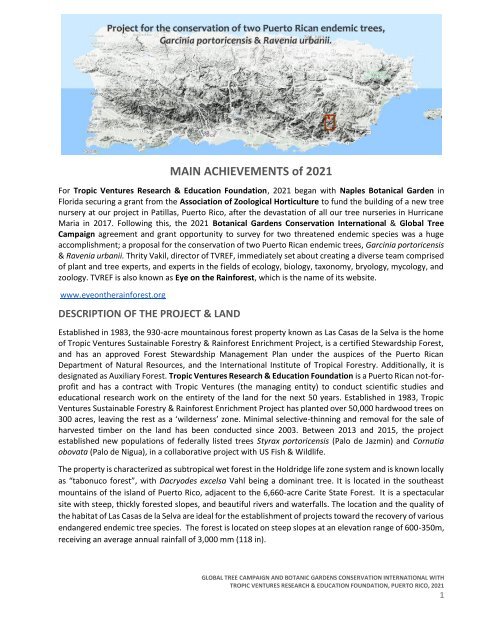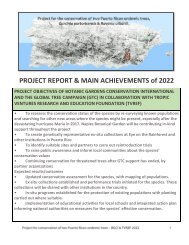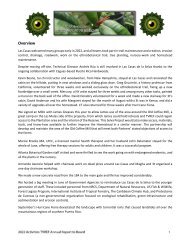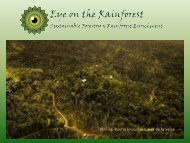TVREF + BGCI MAIN Achievements of 2021
You also want an ePaper? Increase the reach of your titles
YUMPU automatically turns print PDFs into web optimized ePapers that Google loves.
<strong>MAIN</strong> ACHIEVEMENTS <strong>of</strong> <strong>2021</strong><br />
For Tropic Ventures Research & Education Foundation, <strong>2021</strong> began with Naples Botanical Garden in<br />
Florida securing a grant from the Association <strong>of</strong> Zoological Horticulture to fund the building <strong>of</strong> a new tree<br />
nursery at our project in Patillas, Puerto Rico, after the devastation <strong>of</strong> all our tree nurseries in Hurricane<br />
Maria in 2017. Following this, the <strong>2021</strong> Botanical Gardens Conservation International & Global Tree<br />
Campaign agreement and grant opportunity to survey for two threatened endemic species was a huge<br />
accomplishment; a proposal for the conservation <strong>of</strong> two Puerto Rican endemic trees, Garcinia portoricensis<br />
& Ravenia urbanii. Thrity Vakil, director <strong>of</strong> <strong>TVREF</strong>, immediately set about creating a diverse team comprised<br />
<strong>of</strong> plant and tree experts, and experts in the fields <strong>of</strong> ecology, biology, taxonomy, bryology, mycology, and<br />
zoology. <strong>TVREF</strong> is also known as Eye on the Rainforest, which is the name <strong>of</strong> its website.<br />
www.eyeontherainforest.org<br />
DESCRIPTION OF THE PROJECT & LAND<br />
Established in 1983, the 930-acre mountainous forest property known as Las Casas de la Selva is the home<br />
<strong>of</strong> Tropic Ventures Sustainable Forestry & Rainforest Enrichment Project, is a certified Stewardship Forest,<br />
and has an approved Forest Stewardship Management Plan under the auspices <strong>of</strong> the Puerto Rican<br />
Department <strong>of</strong> Natural Resources, and the International Institute <strong>of</strong> Tropical Forestry. Additionally, it is<br />
designated as Auxiliary Forest. Tropic Ventures Research & Education Foundation is a Puerto Rican not-forpr<strong>of</strong>it<br />
and has a contract with Tropic Ventures (the managing entity) to conduct scientific studies and<br />
educational research work on the entirety <strong>of</strong> the land for the next 50 years. Established in 1983, Tropic<br />
Ventures Sustainable Forestry & Rainforest Enrichment Project has planted over 50,000 hardwood trees on<br />
300 acres, leaving the rest as a ‘wilderness’ zone. Minimal selective-thinning and removal for the sale <strong>of</strong><br />
harvested timber on the land has been conducted since 2003. Between 2013 and 2015, the project<br />
established new populations <strong>of</strong> federally listed trees Styrax portoricensis (Palo de Jazmin) and Cornutia<br />
obovata (Palo de Nigua), in a collaborative project with US Fish & Wildlife.<br />
The property is characterized as subtropical wet forest in the Holdridge life zone system and is known locally<br />
as “tabonuco forest”, with Dacryodes excelsa Vahl being a dominant tree. It is located in the southeast<br />
mountains <strong>of</strong> the island <strong>of</strong> Puerto Rico, adjacent to the 6,660-acre Carite State Forest. It is a spectacular<br />
site with steep, thickly forested slopes, and beautiful rivers and waterfalls. The location and the quality <strong>of</strong><br />
the habitat <strong>of</strong> Las Casas de la Selva are ideal for the establishment <strong>of</strong> projects toward the recovery <strong>of</strong> various<br />
endangered endemic tree species. The forest is located on steep slopes at an elevation range <strong>of</strong> 600-350m,<br />
receiving an average annual rainfall <strong>of</strong> 3,000 mm (118 in).<br />
GLOBAL TREE CAMPAIGN AND BOTANIC GARDENS CONSERVATION INTERNATIONAL WITH<br />
TROPIC VENTURES RESEARCH & EDUCATION FOUNDATION, PUERTO RICO, <strong>2021</strong><br />
1
Blue line indicates Las Casas de la Selva property boundary in Patillas, Puerto Rico<br />
PROJECT OBJECTIVES OF BOTANIC GARDENS CONSERVATION INTERNATIONAL<br />
AND THE GLOBAL TREE CAMPAIGN IN COLLABORATION WITH <strong>TVREF</strong><br />
• To reassess the conservation status <strong>of</strong> the species by re-surveying known populations and searching<br />
for other new areas where the species might be present, especially after the devastating hurricane Maria in<br />
2017; Naples BG will be contributing in-kind support throughout the project<br />
• To create genetically representative ex-situ collections at Eye on the Rainforest and other<br />
institutions in Puerto Rico<br />
• To identify suitable sites and partners to carry out reintroduction trials<br />
• To raise public awareness and inform local communities about the species’ conservation values<br />
• Continuing conservation for threatened trees after GTC support has ended, by partner organization<br />
Expected results/outcomes<br />
• Updated conservation assessment for the species, with mapping <strong>of</strong> populations.<br />
• Ex-situ collections established and performance trials initiated for the species. These collections will<br />
be shared with other institutions in the country.<br />
• In-situ programs established for the protection <strong>of</strong> existing populations with planting carried out<br />
where suitable.<br />
• Implementation <strong>of</strong> educational activities for local schools and integrated action plan informing<br />
national authorities on measures for the species’ effective conservation.<br />
SURVEYS<br />
In <strong>2021</strong> seven expeditions were carried out. Target species were found in two surveys, out <strong>of</strong> a total <strong>of</strong> four<br />
field surveys, and then three expeditions were made specifically to search for fruit and flowers at those<br />
locations and to collect material as appropriate.<br />
GLOBAL TREE CAMPAIGN AND BOTANIC GARDENS CONSERVATION INTERNATIONAL WITH<br />
TROPIC VENTURES RESEARCH & EDUCATION FOUNDATION, PUERTO RICO, <strong>2021</strong><br />
2
<strong>2021</strong> REPORT ON “Palo de Cruz” Garcinia portoricensis (Urb.) Alain<br />
Garcinia portoricensis (Urb.) Alain, in the Clusiaceae family, is a slow-growing Puerto Rican endemic tree<br />
found in moist forests on volcanic and limestone substrates, from low to middle elevations (10-930m asl,<br />
Axelrod 2011). The leaves are simple opposite, obovate, shiny dark-green, thick and stiff, with a sunken vein,<br />
and curved downward from the long-pointed base to the long-pointed needle-like apex. The margins are<br />
turned under slightly, and the abaxial side is light-green. The bark is brown, smooth, and slightly fissured,<br />
the twigs are green and angled when young. Flowers are one or several at leaf bases, inconspicuous at 5<br />
mm across, with four creamy-yellow petals, tinged pink at the base. Flowers produce 7-10 stamens (about<br />
18 in male flowers) and a pistil with a 2-celled ovary (Little et al. 1964). Previous authors (Little et al. 1964)<br />
reported that the species develops bisexual and unisexual flowers on the same or in different trees<br />
(polygamous or dioecious). The mature fruit we observed 35mm long had a bright yellow, shiny skin,<br />
elliptical in shape, and thin white flesh inside covering two small brown seeds. The seeds were 15mm in<br />
length. The wood was described as very hard and heavy, (specific gravity 0.9), and very fine-textured, (Little<br />
et al. 1964). There is at least another rare endemic species, Garcinia hessii (Britton) Alain, very similar in<br />
appearance, and limited to forests on serpentine geology in the southwest <strong>of</strong> Puerto Rico.<br />
The habitat for this species was on the slope or lower areas rather than the crest. Dominating species were<br />
different although relatively close to the Ravenia habitats, grasses like Andropogon bicornis dominated<br />
these areas rather than ferns. Only two mature individuals were found on our extensive exploration, flowers<br />
were observed, and recruitment <strong>of</strong> seedlings was observed below one <strong>of</strong> the trees. The other tree had fallen,<br />
possibly toppled by Hurricane Maria, and though significant damage was sustained, the tree is alive and<br />
thriving and had the one fruit on it. Many Clusiaceae species are very malleable and bounce back quickly<br />
from physical damage so this is not a significant concern for the species. A population <strong>of</strong> Prescottia<br />
stachyodes was observed thriving in the understory <strong>of</strong> one <strong>of</strong> the trees we encountered, other associated<br />
species were: Myrcia splendens, Alchornea latifolia, Pinzona coriacea, Miconia serrulata, and Coccoloba<br />
swartzii.<br />
Garcinia portoricensis flowers and buds<br />
GLOBAL TREE CAMPAIGN AND BOTANIC GARDENS CONSERVATION INTERNATIONAL WITH<br />
TROPIC VENTURES RESEARCH & EDUCATION FOUNDATION, PUERTO RICO, <strong>2021</strong><br />
3
This Garcinia portoricensis has a vine-like branching form<br />
GLOBAL TREE CAMPAIGN AND BOTANIC GARDENS CONSERVATION INTERNATIONAL WITH<br />
TROPIC VENTURES RESEARCH & EDUCATION FOUNDATION, PUERTO RICO, <strong>2021</strong><br />
4
1. We found two trees and 6 seedlings. Only one fruit <strong>of</strong> the Garcinia portoricensis was found on the<br />
Las Casas de la Selva land on 6 th July <strong>2021</strong>; the two small seeds were propagated on 8 th July <strong>2021</strong>,<br />
and successfully germinated in the nursery 18 th August, 41 days later. At the end <strong>of</strong> the year, they<br />
are alive and well. LC<br />
2. We received by mail, fruits <strong>of</strong> Garcinia portoricensis (from the private garden in Luquillo, NE, <strong>of</strong> a<br />
US Fish & Wildlife biologist, who, many years ago had grown a G. portoricensis from seed from an<br />
El Yunque National Forest parent). From 90 seeds from these fruits, harvested 15 th April <strong>2021</strong>,<br />
propagated on 26 th April <strong>2021</strong>, 72 germinated in early June <strong>2021</strong>, 40 days later, have survived and<br />
are thriving. LUQ<br />
3. 32 seeds <strong>of</strong> Garcinia portoricensis from Quebradillas (by Octavio) harvested 4 th July, propagated<br />
8 th July, all germinated 13 th September, <strong>2021</strong>, 67 days later. Q<br />
4. We received 8 seedlings <strong>of</strong> Garcinia portoricensis from San Juan FLMM (by Steve- Parqué Dona<br />
Ines). They are thriving in the nursery. We know that the parent tree is from Quebradillas. SJ<br />
With four sets <strong>of</strong> seeds and seedlings, and leaf morphology to compare, there is definitely a question that<br />
needs further investigation, concerning the species. The seedlings from the NE side <strong>of</strong> PR (LC & LUQ) are<br />
from small ovoid fruits and small seeds, and the seedlings from Quebradillas, and the <strong>of</strong>fspring from San<br />
Juan (Q & SJ), are from larger round fruits, and significantly larger seeds. Is this potentially another species?<br />
Left: Fruit and seeds from Garcinia portoricensis, Las Casas land, Patillas, PR (LC)<br />
Right: Seeds Garcinia portoricensis from Quebradillas, PR (Q)<br />
GLOBAL TREE CAMPAIGN AND BOTANIC GARDENS CONSERVATION INTERNATIONAL WITH<br />
TROPIC VENTURES RESEARCH & EDUCATION FOUNDATION, PUERTO RICO, <strong>2021</strong><br />
5
Garcinia portoricensis<br />
Total no. seeds collected from in<br />
situ populations 2<br />
2 from our land, Las Casas de la Selva(LC)<br />
2 survived<br />
18° 4' 33.773"N -66° 1'58.008"W<br />
LC<br />
Total no. individuals sampled for<br />
seed/cuttings collected from 2<br />
Trees on our land<br />
18° 4' 33.773"N -66° 1'58.008"W<br />
18° 4' 33.241"N -66° 2'2.036"W<br />
90 From private garden NE (Luquillo, Barrio Casa Blanca.)<br />
The parent tree was from the upper valley <strong>of</strong> Quebrada<br />
Grande, on the west side <strong>of</strong> El Yunque National Forest.<br />
72 survived<br />
18°20'55.6"N 65°42'32.6"W<br />
LUQ<br />
32 from Quebradillas, North <strong>of</strong> PR (public land):<br />
22 survived<br />
Total no. seeds received from other<br />
18°28'59.8"N 66°54'08.0"W<br />
institutions and propagated 122<br />
Total no. seedlings received from<br />
other institutions 9<br />
Total no. cuttings collected from in<br />
situ populations 21<br />
9 from San Juan, (Parque Dona Ines)<br />
9 survived<br />
18° 38' 76"N -66° 02'82"W<br />
From our land: 3 survived<br />
Q<br />
SJ<br />
LC<br />
Garcinia portoricensis fruit from Las Casas de la Selva<br />
See photos <strong>of</strong> the tree<br />
GLOBAL TREE CAMPAIGN AND BOTANIC GARDENS CONSERVATION INTERNATIONAL WITH<br />
TROPIC VENTURES RESEARCH & EDUCATION FOUNDATION, PUERTO RICO, <strong>2021</strong><br />
6
Garcinia portoricensis<br />
LC<br />
LUQ<br />
SJ<br />
Q<br />
GLOBAL TREE CAMPAIGN AND BOTANIC GARDENS CONSERVATION INTERNATIONAL WITH<br />
TROPIC VENTURES RESEARCH & EDUCATION FOUNDATION, PUERTO RICO, <strong>2021</strong><br />
7
LAS CASAS Garcinia portoricensis<br />
LUQUILLO Garcinia portoricensis<br />
QUEBRADILLAS Garcinia portoricensis<br />
SAN JUAN Garcinia portoricensis<br />
GLOBAL TREE CAMPAIGN AND BOTANIC GARDENS CONSERVATION INTERNATIONAL WITH<br />
TROPIC VENTURES RESEARCH & EDUCATION FOUNDATION, PUERTO RICO, <strong>2021</strong><br />
8
<strong>2021</strong> REPORT ON “Tortugo Prieto” Ravenia urbanii Engl.<br />
Ravenia urbanii Engl. in the Rutaceae family is an endemic tree found in moist forests in eastern Puerto Rico.<br />
Its leaves are simple, opposite, stalk-less, elliptical, short-pointed, leathery, and dark-green with tiny gland<br />
dots. New leaves are glossy bright green. The flowers, with five petals, form asymmetrical, short-tubular<br />
corollas that are vivid pink. The four stamens <strong>of</strong> the flower are epipetalous, (attached to the petals), with<br />
only two being fertile (Little et al. 1974). The ripe fruit comprises five dry brown follicles with 1-2 seeds each<br />
5mm in size. The seed shows ornamentation (not smooth). Often seen as a shrub <strong>of</strong> one to two meters at<br />
most, but documented on our surveys at Las Casas de la Selva as a tree <strong>of</strong> at least 7 meters high. When<br />
young the bark is grayish, when mature the hard bark peels <strong>of</strong>f in scales revealing a series <strong>of</strong> brown tones,<br />
similar to many other Caribbean native hardwood species, like Guaiacum <strong>of</strong>ficinale, Psidium guajava,<br />
Sideroxylon foetidissimum.<br />
See photos <strong>of</strong> the tree<br />
Ravenia urbanii: 1: Fruiting stage. 2: Sepal. 3: Two follicles. 4: Endocarp. 5: Seeds<br />
There is no common English name for this tree.<br />
Perhaps the common name in Spanish, Tortugo<br />
Prieto, (literally dark turtle), derives from the<br />
similarity <strong>of</strong> the rhytidome or outer bark <strong>of</strong> Ravenia<br />
urbanii to the keratinous scutes on a turtle shell.<br />
GLOBAL TREE CAMPAIGN AND BOTANIC GARDENS CONSERVATION INTERNATIONAL WITH<br />
TROPIC VENTURES RESEARCH & EDUCATION FOUNDATION, PUERTO RICO, <strong>2021</strong><br />
9
Left: Steve Maldonado, flagging a Ravenia urbanii tree in the Las Casas forest. Right: bark, which is very hard and<br />
durable, and comes <strong>of</strong>f the tree in large scales.<br />
The habitat we observed for this species was mostly on exposed ridges where the species was<br />
occasional. LsF—Los Guineos clay is the soil series where the individuals were observed growing which<br />
points at clayey soils <strong>of</strong> volcanic origin as the preferred substrate for the growth <strong>of</strong> this species.<br />
Although we did encounter individuals on more diverse forest patches where typical Manilkara-Sloanea-<br />
Dacryodes association occurred, most <strong>of</strong> the individuals we observed were found on ‘savannah-like’ habitats<br />
where they were the canopy species along with Tabebuia schumanniana, another endemic, and more<br />
rarely Cordia borinquensis and Cyrilla racemiflora. It had also been previously collected at least once in 2007<br />
by Dr. Pedro Acevedo & Thrity Vakil at the property and several times in the nearby Carite State Forest.<br />
Understory species were dominated by the tree ferns, Cyathea borinquena. Under the dense ferns,<br />
recruitment was observed, as well as juvenile or young individuals. At least one orchid species was observed<br />
growing epiphytically on mature Ravenia individuals, Epidendrum boricuarum.<br />
Individuals, in general, seemed to be healthy, many in flower and very few in fruit. No individuals<br />
encountered presented obvious damage caused by the hurricanes or by other threats such as herbivory,<br />
fires, diseases, etc. Where Ravenia was present, we observed dense Scleria spp. mats and walls, along with<br />
many vine species; this does not seem to be normal but rather a response to the ample exposure to sunlight<br />
by the decimation <strong>of</strong> the general forest canopy by the hurricane. This does not seem to be an issue for<br />
Ravenia development, only posing an issue for access to sites, at least temporarily, due to the razor-sharp<br />
cutting edges <strong>of</strong> this Cyperaceae. An alternate habitat may be dominated by Gleichnaceae species.<br />
Another site with similar characteristics we encountered provided a more diverse species composition<br />
although Cyathea borinquena and Scleria spp. still dominated most <strong>of</strong> the understory. These other species<br />
were: Lasianthus lanceolatus, Myrcia fenzliana, Cassipourea guianensis, Lasciasis divaricata, Daphnopsis<br />
GLOBAL TREE CAMPAIGN AND BOTANIC GARDENS CONSERVATION INTERNATIONAL WITH<br />
TROPIC VENTURES RESEARCH & EDUCATION FOUNDATION, PUERTO RICO, <strong>2021</strong><br />
10
philippiana, Henriettea squamulosa, Trichilia pallida, Coccoloba swartzii, Alsophila portoricensis, Clusia<br />
gundlachii, and young Terminalia tetraphylla.<br />
Introduced species and more weedy species seem to thrive on wetland-like patches that were adjacent to<br />
these populations, some <strong>of</strong> these species are Swietenia x aubrevillana (planted), Etlingera elatior (probably<br />
planted and escaped), Bambusa chungii (probably planted long ago), Syzygium jambos, Oeceoclades<br />
maculata and Pueraria phaseoloides.<br />
WHAT WE FOUND<br />
We found a total <strong>of</strong> 104 Ravenia trees mostly in flower, and 65 seedlings. We bagged, with old garlic net<br />
bags, the elusive, almost invisible, dehiscent fruits, whose pericarp splits open at maturity and releases the<br />
seeds, which are undetectable once on the ground. Very few people have ever seen the fruit or the seeds<br />
<strong>of</strong> the Ravenia tree. We collected 6 seeds in total, three weeks after bagging. Cuttings: We are<br />
experimenting with growing mediums, potting soils, and perlite; mostly all thrived, and sprouted new shoots<br />
or leaves, and seemed to be just fine, but slowly, all but one died. Thrity is just starting another experiment<br />
as <strong>of</strong> the time <strong>of</strong> writing this report. This time the cuttings are placed at an angle into just damp perlite,<br />
10cm depth in a large, clear, closed container to generate warmth and moisture. The current nursery has<br />
shade cloth so the amount <strong>of</strong> water was not been regulated, and the cuttings were likely receiving too much<br />
water. We need a more controlled environment. In 2022, we will make that environment & hope to train in<br />
more protocols for success in cutting propagation.<br />
Total no. seeds collected from in situ<br />
populations 6<br />
Total no. individuals sampled for seed /<br />
cuttings collected from 5<br />
From our land.<br />
Trees on our land<br />
18° 4' 33.773"N -66° 1'58.008"W<br />
18° 4' 33.241"N -66° 2'2.036"W<br />
Total no. seeds received from other<br />
institutions and propagated 0<br />
Total no. seedlings received from other<br />
institutions 0<br />
Total no. cuttings collected from in situ From our land, only 1 survived so far.<br />
populations 24<br />
GLOBAL TREE CAMPAIGN AND BOTANIC GARDENS CONSERVATION INTERNATIONAL WITH<br />
TROPIC VENTURES RESEARCH & EDUCATION FOUNDATION, PUERTO RICO, <strong>2021</strong><br />
11
MEET THE TEAM<br />
See this link for all team Bios<br />
Thrity ‘3t’ Vakil - Sustainable Forestry, <strong>TVREF</strong><br />
Alejandro Cubiñá - Ecologist & Native Tree Producer, Reforesta, Inc.<br />
Steve Maldonado Silvestrini - Plant Taxonomist<br />
Roberto ‘Roqui’ Bello – Naturalist<br />
Carlos Laboy - Naturalist & Farmer, Reforesta, Inc.<br />
Octavio Rivera Hernández – Agronomist<br />
Dr. Pedro Acevedo - Botanist, Smithsonian Institution<br />
Dr. Eugenio Santiago - Pr<strong>of</strong>essor, Botanist, University <strong>of</strong> Puerto Rico<br />
Dr. James Ackerman - Tropical Ecologist, Taxonomist & Botanist<br />
Dr. Amelia Merced - Botanist, Bryophyte Specialist<br />
Kurt Miller – Mycologist<br />
Agro. Christian Torres Santana - Botanist, Certified Arborist and Horticulturist<br />
Magha Garcia - Sociologist, Farmer & Environmental Activist<br />
PRESS + PRESENTATIONS<br />
In <strong>2021</strong>, the Global Tree Campaign has partnered with Eye on the Rainforest, a Puerto Rican NGO, with<br />
the aims <strong>of</strong> conserving tree species most at risk <strong>of</strong> extinction by increasing the technical capacity <strong>of</strong> project<br />
partners and improving the conservation status <strong>of</strong> these tree species.<br />
https://globaltrees.org/projects/securing-the-conservation-<strong>of</strong>-endemic-trees-in-puerto-rico/<br />
Thrity made a virtual presentation to the Rotary Club <strong>of</strong> San Juan in September <strong>2021</strong>.<br />
Conserve Magazine: https://www.naplesgarden.org/wp-ontent/uploads/<strong>2021</strong>/08/Conserve.pdf<br />
See pages 16 to 20.<br />
Earthday Botanical Survey <strong>2021</strong>, at Las Casas de la Selva, Sustainable forestry & Rainforest Enrichment<br />
Project in Patillas, Puerto Rico. https://youtu.be/i2t4ISqMbIk<br />
A short drone flight over Las Casas de la Selva, Sustainable Forestry & Rainforest Enrichment Project,<br />
established in 1983 in Patillas, Puerto Rico. August <strong>2021</strong>. Footage by Brent Foley, Production by Alfredo<br />
Lopez. https://youtu.be/a0sWtKhS8PI<br />
GLOBAL TREE CAMPAIGN AND BOTANIC GARDENS CONSERVATION INTERNATIONAL WITH<br />
TROPIC VENTURES RESEARCH & EDUCATION FOUNDATION, PUERTO RICO, <strong>2021</strong><br />
12
Watch our 3 minute video on YouTube:<br />
Earthday Botanical Survey <strong>2021</strong>, at Las Casas de la Selva, Patillas, Puerto Rico.<br />
https://youtu.be/i2t4ISqMbIk<br />
GLOBAL TREE CAMPAIGN AND BOTANIC GARDENS CONSERVATION INTERNATIONAL WITH<br />
TROPIC VENTURES RESEARCH & EDUCATION FOUNDATION, PUERTO RICO, <strong>2021</strong><br />
13
NURSERY<br />
As a result <strong>of</strong> <strong>TVREF</strong> obtaining a grant from the AZH through Naples Botanical Gardens, architect David<br />
Henebry designed and led the building-work <strong>of</strong> a new, strong, hurricane-resistant shade-tree nursery in<br />
March <strong>2021</strong>, with cement footings. Additionally the broken hoop-house was fixed, and a small soil shed<br />
built. The funding from <strong>BGCI</strong> has allowed the confidence to expand the nursery, make and add more tables,<br />
buy good growing mediums, allow nursery work to be done regularly, enable the collection <strong>of</strong> seeds from<br />
many other endangered plants, enable more propagation, and enable areas to be cleared <strong>of</strong> undergrowth<br />
to create shaded areas under trees for growing tree seedlings. Here are some images <strong>of</strong> construction and<br />
more.<br />
GLOBAL TREE CAMPAIGN AND BOTANIC GARDENS CONSERVATION INTERNATIONAL WITH<br />
TROPIC VENTURES RESEARCH & EDUCATION FOUNDATION, PUERTO RICO, <strong>2021</strong><br />
14
Currently working on a seedling nursery for protection from birds, and rodents.<br />
GLOBAL TREE CAMPAIGN AND BOTANIC GARDENS CONSERVATION INTERNATIONAL WITH<br />
TROPIC VENTURES RESEARCH & EDUCATION FOUNDATION, PUERTO RICO, <strong>2021</strong><br />
15
SOME OF THE PLANTS AND TREES THAT ARE CURRENTLY GROWING IN THE<br />
NURSERY AT LAS CASAS DE LA SELVA, PATILLAS, PUERTO RICO.<br />
Species: Swietenia aubrevilleana<br />
Common Name: Mahogany<br />
Family: Meliaceae<br />
Species: Swietenia mahagoni<br />
Common Name: Cuban Mahogany<br />
Family: Meliaceae<br />
Species: Hibiscus elatus<br />
Common Name: Blue Mahoe<br />
Family: Malvaceae<br />
Species: Prunus occidentalis<br />
Common Name: Almendrón<br />
Family: Rosaceae<br />
Species: Hymenaea courbaril<br />
Common Name: Algarrobo/Jatobá<br />
Family: Fabaceae<br />
Species: Eugenia stahlii<br />
Common Name: Guayabota (E)<br />
Family: Myrtaceae<br />
GLOBAL TREE CAMPAIGN AND BOTANIC GARDENS CONSERVATION INTERNATIONAL WITH<br />
TROPIC VENTURES RESEARCH & EDUCATION FOUNDATION, PUERTO RICO, <strong>2021</strong><br />
16
Species: Inga Spectabilis<br />
Common Name: Machete<br />
Family: Fabaceae<br />
Species: Triplaris cumingiana<br />
Common Name: Ant Tree<br />
Family: Polygonaceae<br />
Species: Manilkara bidentata<br />
Common Name: Ausubo<br />
Family: Sapotaceae<br />
Species: Crescentia cujete x<br />
portoricensis<br />
Common Name: Calabash<br />
Family: Bignoniaceae<br />
Species: Pisonia hornea<br />
Common Name: Corcho (E)<br />
Family: Nyctaginaceae<br />
Species: Simarouba tulae<br />
Common Name: AceitilloFalso (E)<br />
Family: Simaroubaceae<br />
GLOBAL TREE CAMPAIGN AND BOTANIC GARDENS CONSERVATION INTERNATIONAL WITH<br />
TROPIC VENTURES RESEARCH & EDUCATION FOUNDATION, PUERTO RICO, <strong>2021</strong><br />
17
Species: Goetzea elegans<br />
Common Name: Matabuey (E)<br />
Family: Solanaceae<br />
Species: Erythrina herbacea<br />
Common Name: Coral bean<br />
Family: Fabaceae<br />
Species: Eugenia haematocarpa<br />
Common Name: Uvillo (E)<br />
Family: Myrtaceae<br />
Species: Libidibia monosperma<br />
Common Name: Cobana negra<br />
Family: Fabaceae<br />
Species: Japtropha multifida<br />
Common Name: Coralbush<br />
Family: Euphorbiaceae<br />
Species: Machaerium lunatum<br />
Common Name: Palo de Hoz<br />
Family: Fabaceae<br />
GLOBAL TREE CAMPAIGN AND BOTANIC GARDENS CONSERVATION INTERNATIONAL WITH<br />
TROPIC VENTURES RESEARCH & EDUCATION FOUNDATION, PUERTO RICO, <strong>2021</strong><br />
18
Species: Aiphanes acanthophylla<br />
Common Name: Palma de Coyer<br />
Family: Arecaceae<br />
Species: Copaifera <strong>of</strong>ficinalis<br />
Common Name: Copaiba balsam<br />
Family: Fabaceae<br />
Species: Sandoricum koetjape<br />
Common Name: Santol<br />
Family: Meliaceae<br />
Species: Albizia lebbeck<br />
Common Name: Shak Shak Tree<br />
Family: Fabaceae<br />
Species: Quararibea turbinata<br />
Common Name: Swizzle stick/Garrocho<br />
Family: Malvaceae<br />
Species: Handroanthus chrysanthus<br />
Common Name: Roble amarillo<br />
Family: Bignoniaceae<br />
GLOBAL TREE CAMPAIGN AND BOTANIC GARDENS CONSERVATION INTERNATIONAL WITH<br />
TROPIC VENTURES RESEARCH & EDUCATION FOUNDATION, PUERTO RICO, <strong>2021</strong><br />
19
Species: Senna polyphylla<br />
Common Name: Desert cassia<br />
Family: Fabaceae<br />
Species: Crescentia portoricensis x<br />
linearifolia<br />
Common Name: Calabash tree<br />
Family: Bignoniaceae<br />
Species: Synsepalum dulcificum<br />
Common Name: Miracle Fruit<br />
Family: Sapotaceae<br />
Species: Siphoneugena densiflora<br />
Common Name: Hoja menuda<br />
Family: Myrtaceae<br />
Species: Cornutia obovata<br />
Common Name: Palo de Nigua<br />
Family: Lamiaceae<br />
Species: Garcinia portoricensis<br />
Common Name: Palo de Cruz<br />
Family: Clusiaceae<br />
GLOBAL TREE CAMPAIGN AND BOTANIC GARDENS CONSERVATION INTERNATIONAL WITH<br />
TROPIC VENTURES RESEARCH & EDUCATION FOUNDATION, PUERTO RICO, <strong>2021</strong><br />
20
Species: Garcinia intermedia<br />
Common Name: Lemondrop<br />
Family: Clusiaceae<br />
Species: Annona muricata<br />
Common Name: Guanabana<br />
Family: Annonaceae<br />
Species: : Psidium guajava<br />
Common Name: Guava<br />
Family: Myrtaceae<br />
Species: Psychotria viridis<br />
Common Name: Chacruna<br />
Family: Rubiaceae<br />
Species: Brunfelsia portoricensis (E)<br />
Common Name: Rain Tree (E)<br />
Family: Solanaceae<br />
Species: Banisteriopsis caapi<br />
Common Name: Yagé<br />
Family: Malpighiaceae<br />
GLOBAL TREE CAMPAIGN AND BOTANIC GARDENS CONSERVATION INTERNATIONAL WITH<br />
TROPIC VENTURES RESEARCH & EDUCATION FOUNDATION, PUERTO RICO, <strong>2021</strong><br />
21
Location <strong>of</strong> Surveys: https://www.inaturalist.org/observations?d1=<strong>2021</strong>-01-01&d2=<strong>2021</strong>-12-13&nelat=18.10318806551125&nelng=-<br />
66.00861193203258&place_id=any&subview=map&swlat=18.03559596302962&swlng=-<br />
66.05121002050537&user_id=stevemaldonadosilvestrini&verifiable=any<br />
Thank you for collaborating with us. Trees are our future.<br />
All this has been made possible by:<br />
Report by Thrity Vakil, Steve Maldonado, Octavio Rivera, & Dr. Eugenio Santiago<br />
GLOBAL TREE CAMPAIGN AND BOTANIC GARDENS CONSERVATION INTERNATIONAL WITH<br />
TROPIC VENTURES RESEARCH & EDUCATION FOUNDATION, PUERTO RICO, <strong>2021</strong><br />
22







